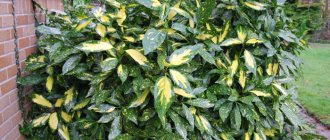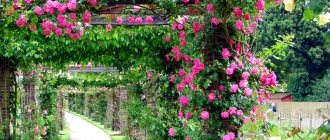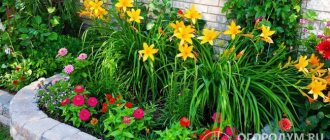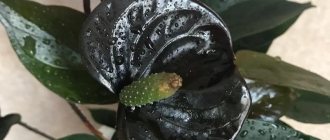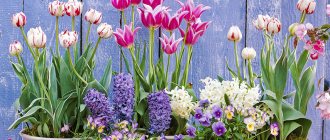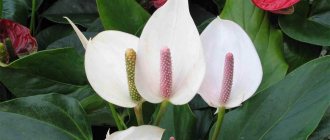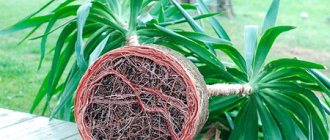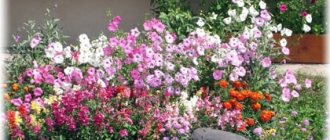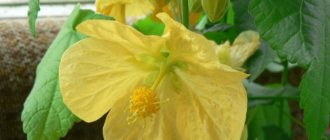Photo: fototerra.ru Since ancient times, blue has symbolized constancy, calm, honesty and kindness. And it’s really easy to note that it has a beneficial effect on mood and inner harmony. It also fills everything around with a feeling of air and freshness. Blue flowers are especially successful in this, which we have collected in today's catalog!
Guidelines for choosing plants
All flowers growing in open areas are divided into 3 groups:
- annual;
- two-year-old;
- perennial
The first includes crops that can completely overcome all stages of life in one season. They develop successfully, decorate inflorescences, pollinate and bear fruit. And in the fall they bear seeds and disappear forever. Despite this, annuals are very popular with designers. The wealth of varieties makes it possible to create unique compositions every year.
After flowering, annual crops can be removed and a new flower bed can be arranged.
In biennial plants, buds appear only in the next season. Some specimens live longer than expected, which is very welcomed by gardeners. However, perennials are considered the most valuable “economy”. They retain their original decorative effect for decades. Most perennials have leaves and branches that die. The underground part renews vegetation as soon as suitable conditions are created. To choose the right flowers for your flower bed, you need to know them. We open and leaf through the “book” of bright plants for the garden.
Annual blue flowers for the garden
In summer, blue flowers fill our gardens with bright splashes of blue or blue. The deep blue tones of flowering plants give them a sense of serenity. What can you choose from annual flower crops for planting in a flower garden?
Evolvulus
Quite rare in our area are low blue flowers for flower beds with a true blue tint. The groundcover Evolvulus looks great on soft grey-green foliage that forms a small mound.
Ageratum
A compact plant 20-35 cm high. It blooms with small flowers collected in spherical or umbrella-shaped inflorescences. Flowering continues from June until frost. Faded inflorescences do not spoil the decorative appearance of flowers. Ageratum is propagated by seeds and cuttings. Used to decorate flower beds.
Calibrachoa
This petunia analogue is relatively new, first becoming available to home gardeners in the 1990s. Advances in breeding have led to a wider range of colors and larger patterns. One of the most versatile annual plants, calibrachoa can be added to any floral arrangement.
Place two tall ceramic vases near the entrance to your home and fill it with vibrant blue flowers to wow visitors. Decorate gazebos and porches with hanging baskets filled with your favorite flowers.
Violet or Pansy
The genus Viola has more than 500 different species, including annual and perennial crops. Varieties grown as garden varieties are mostly annuals with small flowers.
Many will sow themselves and give you years of joy. There is an incredible variety of colors and patterns available for Pansies today, including blue ones.
Aster
Annual species of aster vary in the shape of the bush and the structure of the inflorescences and flowers. They come in low, medium and high. The main stem of the plant is straight and quite strong. Stars reproduce only by seeds. Well-ripened seeds can remain viable for up to 3 years. For early flowering, aster seeds are sown in a greenhouse in mid-March.
cornflower
A durable and persistent flower, which, despite its external fragility and sophistication, easily tolerates cold, wind and prolonged drought. The perennial plant begins to bloom in May, but does not like it for a long time - until mid-June. The flowers are small, in mountain varieties they can reach 15 centimeters in diameter.
Sage or Salvia
Typically blooming from late spring to fall, salvia thrives in dry conditions and appreciates free-draining soil. With regular pruning, sage can bloom from late spring until the first frost.
The variety of colors, sizes and long flowering time make salvia an ideal addition to perennial borders, even when used as an annual.
Petunia
This crop is often grown as an annual. There is a wide variety that may differ in shades. Most often in the garden there are varieties with blue flowers. They are planted to decorate flower beds and borders.
The height of plants can reach half a meter. The stems extend along the surface of the soil. The flowers are funnel-shaped. Abundant and long flowering. Reproduction occurs by seeds. They can be sown in a greenhouse or directly in a permanent place.
bright flower
Nemophila (American forget-me-not)
A plant with highly branched, pubescent stems and widely bell-shaped flowers. Blooms profusely, but not for long. Nemophila is a rather unpretentious plant. It loves humidity and does not require much heat. Tolerates shade, prefers loose, slightly alkaline soils. Used as a ground cover plant.
Nemesia
Native to South Africa, this perennial is grown as an annual and used to decorate borders and rocky areas. Nemesia forms a “carpet” 25-30 cm high and blooms from June to August. Propagated by sowing seeds in greenhouses in February-March, and seedlings are planted in open ground in May.
List of blue flowers with names and photos: field, garden and indoor
Monochrome flower arrangements always remain popular.
To decorate your garden, create an attractive bouquet or furnish your apartment with plants of the same color, you need to distinguish them by their names.
We suggest considering a list of plants that have blue flowers.
Lily leaf bell
The bell belongs to the bellflower class and is a representative of wildflowers. The bell grows in Europe, the Caucasus and western Siberia.
It can often be found in thickets and bushes near rivers. Blue bell flowers can easily be confused with field bells.
There is a slight difference between these plants - the presence of a long pistil in the lily-leaved bell.
The bell is characterized by long flowering, its stem is covered with thin leaves. In Belarus, the bell is listed in the Red Book.
morning glory
An elegant representative of garden plants, which allows you to green fences and fences with its climbing stems.
The sky-blue shades of the flower fascinate garden owners, which is why morning glory is widely used in garden landscaping.
The flower has the shape of a gramophone, its main color is blue with streaks of purple and burgundy. Morning glory is an annual plant and blooms from June until the first frost.
The stems of morning glory are climbing, densely covered with medium-sized leaves. The flower is great for disguising unsightly areas of the garden space.
Lisianthus
A plant with blue or blue flowers, intended for growing indoors. When indoors, this flower reaches a height of 35 cm.
Its flowers are grouped in groups, they have a poppy-like silhouette, and the surface is covered with terry fibers.
Fluffy flowers require constant sunlight, so it is best to place lisianthus in a well-lit window.
Do not forget about the foliage: it must be frequently sprayed with water. Lisianthus requires thorough watering, as well as moderate temperature conditions. In winter, lisianthus is kept in a cool place.
cornflower
The meadow fields of Russia are abundantly covered with this plant. It is also common in the Caucasus. Cornflower is not grown for decorative purposes; it grows near bushes, in fields and meadows.
Cornflower is considered perennial: its stem is rough and reaches a height of 1 meter. The flowers have a blue and purple hue and bloom throughout the summer.
Cornflower is widely used in medicine - it has tannins, has a diuretic, analgesic and anti-inflammatory effect.
blue cyanosis
The plant is used for ornamental gardening and also grows wild in the Caucasus, western Siberia and the European part of Russia.
The stem of the cyanosis is branched, but bare. Small leaves do not completely cover the erect plant. The blue flowers look like small gramophones.
They consist of several boxes, and the pistils protrude forward. Field species of cyanosis grow near wetlands, where humus occurs in the soil.
It can also be found on the edges, near bushes: there the cyanosis is grouped or grows separately.
Piglet auricularis
Houseplants often have fancy names, and vinica is no exception. Its blue flowers are arranged in clusters at the top of the stems, so it creates a beautiful blue crown over the pot.
The stems of the stem are creeping - they can be used to beautifully decorate window openings. In winter and spring, it is recommended to keep the plant cool.
Flowering begins in summer or early autumn. For proper growth, the pigweed must have support in the pot.
When the stems reach 1 meter, they are cut off - it is better to do this in the spring. In summer, watering should be plentiful, and in winter, sparing.
Delphinium or Larkspur
A beautiful tall plant with an erect stem, widespread in central Russia. It grows in wild fields and is also used for ornamental gardening.
The height of larkspur can reach from 50 cm to 2 m; annual and perennial individuals are distinguished. You can admire the blue flowers from the end of June for a whole month.
Delphinium is unpretentious in garden cultivation, but it would be a good idea to install plant supports to avoid damage during bad weather.
You can grow delphinium yourself using cuttings or sowing.
Blue Lily
This name is sometimes given to the blue water lily that grows in bodies of water. Africa is considered the birthplace of the water lily; later it was brought to India and China.
This pale blue flower is widely praised in literature. The peculiarity of the lily is that it blooms on water during the daytime.
It lasts about 3 days, after which it fades. Blue water lily is not only elegant, but also healthy.
It has long been used as an antiseptic with a calming effect. If there is a pond at your summer cottage, you can grow a blue lily yourself.
The plant blooms profusely with beautiful blue and white bells. It is easy to care for at home, so it is widespread among those who like to grow indoor plants.
It is suitable for diffused moderate lighting, a temperature of 18 to 22 degrees, and relatively high humidity.
In the evening the blue flower falls asleep and opens again in the morning. Gloxinia's leaves are rough, so they can retain moisture: this point should be taken into account if the plant is often exposed to the sun.
Garden and indoor plants are equally beautiful as their meadow counterparts. Blue color is designed to calm the nervous system and evoke a feeling of peace.
If you have no inclination to grow flowers, make them yourself from foamiran. They will look lifelike and delight the eye every day with their beauty and elegance.
Useful video
womans7.com
Biennial plants with blue flowers
Biennials are plants that achieve ornamental value in their second year of cultivation. Most of these crops form a rosette of leaves only in the first year. Some of them may bloom, but very weakly. In the second year, the plants develop flowering shoots, bloom profusely and produce seeds.
Biennials reproduce by sowing seeds in April-May, from which seedlings are grown and planted in a permanent place in August-September of the first year. Most of these plants are also capable of vegetative propagation.
Viola
People call this flower “pansy”. Herbaceous plant of low height. The bushes are compact, no more than 30 cm high, the leaf blades have a rich green tint.
Each flower has 5 petals. In cross section, the flowers reach 4-6 cm, depending on the variety. If you plant the giant varieties, they will produce flowers about 10cm in diameter and their petals will have wavy edges. Reproduction occurs by seeds.
Rich flower
Forget-me-not
A low-growing perennial flower garden that will delight the eye all year round, in spring and summer. Forget-me-nots bloom and grow in shady places, in fertile soil soaked in liquid fertilizer. Sowing begins at the end of April, at a distance of 10-20 centimeters from each other, while the bushes are buried deep into the ground. Lack of water and frequent transplants are painful.
Perennial plants with blue flowers
Perennial flower crops develop and bloom in one place for several years. Most often they bloom in the second or third year of life. They reproduce both by seeds and by dividing the bush. These flowers are used in landscape design in single plantings and group compositions. Many of them hibernate outdoors.
Aquilegia
This plant also goes by the names: eagle and columbine. Reaches a height of 40 to 80 cm, has overgrown bushes and single or double flowers with spurs. Aquilegia blooms in May-June. Grows well in any garden soil, both in bright and semi-shaded areas. Mature plants do not tolerate transplantation well. Columbine grows in one place for 3-5 years. Propagated mainly by seeds, less often by dividing the bush.
liverwort
This is a hardy plant with leathery leaves collected in a bunch. Peduncles grow up to 10 cm in height. Liver requires clay soil with humus, frequent watering, and a shady or semi-shady place. The plant propagates by dividing the bush or by seeds.
Mordovnik
The globular flowers of the face attract a beautiful blue hue. Large, deeply dissected leaves are dark green above, lighter below. The plant is suitable for decorating landscape compositions and drawing bouquets of dried flowers.
Delphinium
This is a tall plant, growing up to 2 m. Delphinium has thin stems with pyramidal inflorescences. Flowers with a diameter of 3-7 cm can be single or double. Flowers have spurs on their backs. This feature gave the plant its second name - spurs.
Delphinium blooms in June-July, sometimes again in autumn. The flowers are odorless. The plant prefers calcareous soils and is well fertilized with humus. Easily propagated by sowing seeds, cuttings and dividing roots. Cut inflorescences remain decorative in water for up to 10 days.
Bell
A delicate and fairly common garden plant that decorates the garden for 15 to 90 days (depending on conditions and variety). They prefer sunny areas (with direct rays), but can also grow in partial shade. It is important to avoid standing water and weeds in the surrounding area. Otherwise, the plant does not require serious maintenance.
Agapanthus or African lily
The umbrella inflorescences of this plant complement the garden composition in flower beds or along sidewalk paths. The inflorescences themselves consist of small bright blue flowers. The plant blooms profusely, but not for long - from June to July. Loves sunlight and does not tolerate drought. In areas with cold winters, it is recommended to dig up the bulbs and move them to a warm room for wintering.
Lupine / Lupinus
Mostly one species is grown in gardens: multileaf lupine (Lupinus polyphyllus). A perennial plant up to 120 cm tall, the flowers are collected in multi-flowered racemose inflorescences 30-35 cm long. It blooms in June for 20-30 days. In its natural form the flowers are blue, but cultivars have been developed with red, white, pink, yellow and orange single or bi-color flowers.
Multileaf flower lupine
Of course, the list of plants with blue and blue flowers can be further supplemented and expanded: these are small bulbs (Scilla, Pushkinia and Muscari), these are annuals (asters, petunias), these are also perennials that are not included in our list. We are waiting for your suggestions to expand the list. Write your candidates in the comments.
Geranium / Geranium
Several flowering varieties are of the geranium type. The most fragrant is the Himalayan or large-flowered geranium. Its height is 50 cm. Geranium blooms from May to June and feels most comfortable in partial shade.
.
Veronica dubravnaya
If you want your garden to be full of beauty and grace, plant veronica in your garden. This flower is characterized by blue-blue flowers.
it is easy to care for and can also grow in any area. In the sun's rays, bright flowers look even more aesthetically pleasing.
Looks aesthetically pleasing in the garden
Scabious
This plant is 50-80 cm high with oblong leaves collected in a basal rosette. It blooms from July until frost, grows well in soils fertilized with humus. Prefers open and sunny places, reproduces by dividing the bush and seeds.
Eryngium (eringium)
This beautiful plant prefers hot spots and dry sandy soils. Erythematosus is captivating with its elegance: the blue flower heads are adorned with dissected silver-gray upper leaves. The plant reaches a height of 60-80 cm and blooms in June-August.
Creeping survivor
This plant is frost-resistant and drought-resistant. It can be planted in all types of soil. The peculiarity of this culture is that the tenacious one grows quickly, filling the bald spots in the area.
Persistent flowering begins in late spring and continues until June. Despite the fact that the inflorescences on the bushes last only a few weeks, they will harmoniously decorate your area.
Hardy plant
Erigeron petalata
This unpretentious perennial will not cause any problems for the gardener. It propagates easily and can bloom in one place for 5 years without losing its beauty.
If you want to liven up a dull corner of the garden, then you should plant a small erigeron petal. Fluffy inflorescences combine perfectly with other representatives of the flora, creating a colorful composition.
Brunner
A perennial plant characterized by large leaves located in the root part. The flowers are bluish. The inflorescences are weak.
Reproduction occurs by seeds or division of roots. The procedure is carried out in spring or autumn. The culture needs good moisture. Prefers sunny areas, but can also grow in partial shade.
Broad bell or Platycodon / Platycodon
The plant is 40-80 cm tall, with oval-elliptical serrated leaves and sharp tips. Short bell-shaped flowers with a diameter of 5-7 cm are located on the tips of the shoots in panicle inflorescences.
Platycodon is sensitive to fertilizers, prefers clayey, slightly acidic soils with a sufficient content of humus and a mixture of sand. Propagated by autumn sowing of seeds. After planting it blooms in the third year.
Globularia (globularia)
A herbaceous perennial plant with long leaves collected in dense basal rosettes and stems 5 to 30 cm high. Globularia is perfect for landscaping rock gardens and alpine slides. Flowers without fragrance.
Meconopsis
This perennial plant is also called Himalayan or Tibetan poppy. It is distinguished by its unusual blue coloring of flowers. Meconopsis is native to the highlands of India, China, Burma, Bhutan and Nepal, but has long been widespread throughout Europe. The genus has more than four dozen species, including miniature flowers up to 15 cm tall and powerful two-meter plants.
Subulate Phlox
This creeping perennial forms continuous flower cushions that can become a real decoration of the garden. Subulated phlox is a dwarf form.
Looks great on ridges, edges, rock gardens and along paths. Awl-shaped phlox is used in flower beds as an independent plant and in combination with other flower and ornamental crops.
Kermek
The flower is called statice. The plant has an attractive appearance, so it will beautifully decorate a flower bed. It can be used to create bouquets.
The stems are heavily pubescent. Their height reaches 0.8 m. The flowers have a rich blue tint, but there are varieties with other tones.
Linen
This plant is often used in the production of natural materials. Flax can also be planted as a decoration for the site. Flowers can be of different shades (red, purple and yellow). However, the most popular varieties are those with blue inflorescences.
The crop is propagated by seeds. It should be planted in well-lit areas.
Anagallis
This crop is considered a field crop. Initially it was not popular with gardeners. Subsequently, breeders developed several more varieties, distinguished by deep blue flowers. The bushes evenly and densely cover the soil surface. The height of the plant does not exceed 20 cm.
It is not recommended to over-water the anagallis, as this can lead to rotting. Reproduction occurs by seeds. They need to be planted immediately in mid-spring in a permanent place. Flowering will be bright and abundant if the plant is planted in full sun.
low growing plant
Aconite glomerulosa
An elegant plant with an average height of 80 cm. Glomerular aconite (Aconitum napellus) is covered with large blue panicle inflorescences. Used for small group plantings.
Perennial is a winter-hardy plant. It can grow in one place for up to 8 years.
Gladiolus
A genus of perennials, including numerous species. A popular variety with blue flowers is Blue Mountain).
For gladioli shoots to bloom, they need nutritious, well-warmed soil by the sun.
Depending on the period and environmental conditions, the gladiolus produces purple-blue flowers. Height reaches 120 cm.
Iris
The iris flower has six petals arranged in two circles: three on the outside and three on the inside. The outer petals are curved down, while the inner petals are raised up and often close, which makes the flower unique. Early flowering irises bloom in the first half of May, late ones - in July.
The most common method of vegetative propagation. The plants are undemanding to soil fertility, but grow best on arable land.
Blue and blue flowers at our feet
The famous phrase “There is a time for everything” applies not only to people, but also to plants. Each of them develops at a precisely designated period. And sky-blue flowers decorate our lives with love. Even if it's just one season. Let's get acquainted with the most popular specimens.
cornflower
This unpretentious plant attracts the attention of wildflower fans. It is often found among wheat crops. Cultivated cornflowers fit wonderfully into a country landscape when they are grown in flower beds in company with other flowers. The erect shoots of the plant are strewn with narrow, rich green foliage. When the time comes, the bush puts on a “veil” of many elegant buds, painted in different tones of blue.
The varieties most often grown in flower beds are:
- meadow;
- mountain;
- blue.
Other types of cornflowers are colored lilac, pink and white. However, in a monochrome flower bed, blue annual garden flowers look very stylish. The flowering of the crop begins in the summer and lasts until the first frost. The buds are elegant baskets consisting of delicate petals with a carved frame.
In an ordinary flower bed, cornflowers harmoniously combine with white daisies and scarlet poppies. In monochrome plantings they are often grown with bells.
Petunia
It is impossible to pass by a flower bed with charming flowers that exude a pleasant aroma. Petunias grow in small bushes formed by branched shoots. In the root region there is dark green oval-shaped foliage. Every summer the plant is decorated with delicate buds of almost all colors of the rainbow.
However, only the following varieties are suitable for a monochrome blue flowerbed:
- Blue Waterfall;
- "Pepper blue";
- Blue Ivy;
- Merlin Morn;
- Blue Wave.
Each of them has its own unique beauty. All exude a pleasant aroma that turns the countryside into a garden of delight. Petunia blooms all summer, including September, if the autumn is warm.
Petunia is sown for seedlings in late February or early March. They are transferred to the flowerbed in May.
Asters
At the end of August, summer cottages are decorated with magnificent blue garden flowers with an exquisite aroma. Asters rightfully occupy a special position among their relatives. They are easy to care for, are not afraid of frost and can withstand dry periods. Annual or perennial varieties look spectacular in the gardens of our compatriots.
Particularly attractive are varieties with blue and dark blue buds. The most popular are:
- Alpine blue;
- Lady in Blue;
- Blue Lagoon;
- Little Boy Blue;
- Royal Blue.
The culture has a strong, erect stem that grows from 20 to 85 cm in height. The root system of all species is the same, but the buds are different. Some resemble daisies, others look like chrysanthemums. There is an option for every gardener.
Many people call asters autumn flowers. In fact, the first buds bloom already in June.
Bulbous blue plants
Perennial bulbous plants in open ground are distinguished by the first flowering of all plants. Their underground part is a bulb in which nutrients accumulate and from which a peduncle develops. These plants are best planted in small bushes between ground cover perennials. All bulbous flowers dry up after flowering, their foliage dries up and gives way to neighboring plants.
Iridodictium or iris reticulum
A winter-hardy and light-loving perennial, very similar in appearance to irises. Flower coloring is mainly limited to blue and blue shades. The plant can grow in poor soil. Propagated by daughter bulbs. Iridodiction grows in one place for up to 7 years. It is used to decorate flower beds, rock gardens and alpine slides. The bulbs can be left outdoors over the winter, but it is better to dig them up annually.
Muscari
A small bulbous plant, also called mouse hyacinth, has a height of 15 to 25 cm. Muscari blooms earlier than many other plants - in April-May. They do well in sunny places, such as rock gardens. In addition to beauty and grace, muscari attracts with its unpretentiousness. They adapt very easily to different conditions.
Anemone
This plant is also called “crown anemone”. Bulbous plant. The underground part of the bush consists of small tubers. They need to be dug up for the winter and moved indoors.
The culture begins to bloom in late spring. Sowing should be done in well-lit areas or in the shade. The soil must be well moistened and fed. Therefore, it is advisable to add humus before planting.
Anemone
Scylla
A bulbous perennial, also called blue snowdrop or blueberry. Height - up to 15 cm. It is characterized by early flowering, which occurs in early or mid-March.
Perennial Scylla prefers acidic soils enriched with peat and humus
Blue snowdrops are considered sensitive to lack of light. They do not open in cloudy weather. When the air temperature drops, the stems become violently overturned.
Hyacinth
These little seedlings are the embodiment of spring and emerge from the snow on the first warm days. They are pointed green stems decorated with dense inflorescences with many blue flowers. The plants can grow in flowerbeds or along sidewalks and make great additions to the garden and a fragrant filler to the backyard.
Allium
This plant is also called “decorative onion”. The leaves are located at the roots, and the inflorescences are spherical in shape. Peduncles are tall. The height of the bushes can vary from 30 cm to 1.4 m. It all depends on the chosen variety. The culture tolerates frost well, but prefers sunny areas.
Reproduction is carried out by seeds or bulbs. Onions can be produced by self-sowing. The blue flower for the garden begins to bloom in the second year after planting in a permanent place.
This is what a decorative bow looks like
Chionodoxa
This plant is one of the first to bloom as soon as the snow melts. Its height is 10-15 cm. The flowers are collected in racemose inflorescences. Chionodoxa grows well in full sun to partial shade, but blooms first in full sun. Propagated by seeds and bulbs.
Pushkinia prolesciformes
This miniature ornamental plant is grown in group plantings in rock gardens. In nature, Pushkinia is found in mountain meadows and rocky slopes of the Caucasus and Asian countries. The plant prefers well-drained soil and open sunny places. Propagated by bulbs, pups and seeds. Can grow in one place for 5-7 years.
Annual plants
Thanks to the wide variety of shapes of flowers and inflorescences, as well as abundant flowering, annuals occupy one of the leading places in the decorative design of premises. Annual plants can be grown as cuttings or by sowing in the ground, which greatly reduces costs and makes them easier to grow.
Most annual flowers have a short development cycle and complete it in one growing season. During this time they manage to bloom and produce seeds. Annual plants reproduce quickly, bloom for a long time and are colorful. There are many plants with blue flowers.
cornflower
cornflower
A rather undemanding plant with staminate leaves, reaching a height of 20 to 90 cm. It blooms from July to September, prefers dry, sunny places, and does not like long-term watering. Propagated by division and seeds.
Nemophila (American forget-me-not)
Nemophila (American forget-me-not).
A plant with scaly, highly branched stems and widely colored flowers. Blooms profusely, but not for long. Nemophila is a rather undemanding plant. It is very hygrophilic and does not have any special requirements for heat. Shade-tolerant and very tolerant plant, prefers loose, slightly alkaline soils. Can be used as a ground cover plant.
Heliotrope
Heliotrope
Heliotrope is grown as an annual plant. This is a small shrub 60 cm high with a branched stem. Small, fragrant flowers are collected in disc-shaped inflorescences reaching 15 cm in width. Heliotrope blooms from June until frost. A characteristic feature is the ability to turn towards the light source. Cut inflorescences can be dried in partial shade for winter bouquets, preserving their decorative effect for up to 5 years.
Nigella (damascus nigella)
Nigella (Damascus nigella).
An annual plant with vertical, up to 60 cm tall, highly branched stems with overhanging leaves. Flowers, up to 4 cm in diameter, can be simple or lush. This undemanding plant blooms in late June - early July. Nigella is light and cold resistant. Propagated by seeds sown in April in open ground.
morning glory
Ipomea
This fast-growing rock garden can reach 3-4 m in height. It has pointed, heart-shaped leaves and funnel-shaped flowers 4-6 cm in diameter, which become covered when it is cloudy or at night. Blooms from June until frost. Propagated by sowing seeds in open ground. Prefers sunny places. Requires support and can be used for gazebos, balconies, fences and walls.
Anagallis
Anagallis
This common field grass was not very popular until breeders developed a variety with blue flowers and creeping stems that cover the ground abundantly. Anagallis grows to a height of about 20 cm and does not tolerate too much moisture, which can cause root rot. It can withstand prolonged drought. Propagated by seeds sown directly into the ground in April. Massive flower formation occurs in full sun.
Lobelia
Lobelia
An indispensable plant for carpet compositions, low borders and rocky areas. Lobelia is a perennial, but is used as an annual. Its slender stems reach 10-15 cm in height. It forms dense, compact bushes and blooms from June until frost. Propagated by sowing seeds in greenhouses in February-March and in open ground in May.
Ageratum
Ageratum
This compact plant grows 20-35 cm in height and has small umbrella-shaped or spherical flowers. Flowering continues from June until frost. Faded inflorescences do not spoil the decorative appearance of flowers. Ageratum is propagated by seeds and cuttings. It can be used to decorate flower beds.
Nemesia
Nemesia
A perennial native to South Africa, grown as a summer plant, used in borders and for landscaping rocky areas. Nemesia forms a mat 25-30 cm high, which blooms from June to August. Propagated by sowing from seeds in greenhouses in February-March and planting in open ground in May.
Petunia
Petunia
Petunia is a plant 25-50 cm tall with creeping stems and funnel-shaped flowers. Very lush and long flowering. Propagated by sowing seeds in a greenhouse or in open ground. Petunia is widely used for planting in flower beds, patios, terraces and balconies. Planting is also possible in containers, decorative vases and flowerpots.
Aster
Aster
Annual asters differ in bush shape, inflorescence and flower structure. They are available in low, medium and high versions. The main stem of the plant is straight and quite strong. Asters can be propagated by seeds. Well-ripened seeds can germinate up to 3 years. For early flowering, sow asters in the greenhouse in mid-March.
Ground cover flowers perennials blue
Climbing and climbing plants are no less decorative than standing ones. Ground cover perennials bloom in the area in blue and green at the same time due to the large number of shoots and dense foliage.
morning glory
Low growing, very climbing plant. It is a vine-like perennial with small blue flowers.
Morning glory is used for vertical gardening
Important! The plant contains toxic substances. Therefore, it is planted in places inaccessible to children and animals.
Morning glory has a long flowering period. The perennial blooms in early June and fades with the onset of the first frost.
Lobelia
Perennial herbaceous plant with small blue flowers. It is characterized by rapid growth. Pillow shape. With regular pruning, you can make the flower dome-shaped.
Lobelia needs moisture and sunlight to bloom profusely.
Height - up to 25 cm. Flowers 1.5-2 cm in diameter. Lobelia is used to decorate borders, flowerbeds and flower beds. Often planted in mixborders and rock gardens in front of tall ornamental plants.
Heliotrope
Creeping varieties are used as ground cover. The most common is marine heliotrope. Bush height up to 35 cm.
Heliotropes can be planted in both sun and partial shade.
The decorative value of heliotrope is manifested not only during flowering. It has large, dense foliage that only fades in late fall.
Aubrietta
The Blue Cascade variety is used as a ground cover plant. Perennial herbaceous plant with abundant flowering. This species is one of the evergreen plants. The foliage retains its color most of the year and blooms in early spring.
The annual growth of aubrietta reaches 20 cm
The flower is exceptionally winter hardy. Forms a lush cover on the soil surface. Flowering lasts up to 8 weeks. The foliage remains green until mid-autumn.
Periwinkle
Low-growing perennial up to 15 cm tall. It is resistant to adverse factors. Tolerates cold winters well without affecting the intensity of flowering.
Important! Periwinkles are able to reproduce by self-sowing. If this is not necessary, the pods must be removed from the flower.
Periwinkle is ideal for shady areas
The perennial is not picky about the composition of the soil. But if you plan to grow blue periwinkles for a long time, it is best to plant the flower in fertile soil.
Elegant monochrome mixborder
Once planted, a flowerbed on a summer cottage delights the hearts of its fans for decades. It only requires regular watering, weeding and fertilization. To create such a miracle, you will need perennial blue flowers with graceful bud shapes. Continuing to leaf through the “Book of Creations”, we will select suitable copies.
Delphinium
The tall perennial rises 2 m to the sky. Its slender stems are decorated with graceful buds of a pyramidal nature. On average, the diameter of each of them reaches 7 cm. The inflorescences are both simple and double. There are spurs on the back of the bud. Belladonna is considered a popular type of delphinium with blue and blue flowers.
Taking it as a basis, breeders developed a number of varieties with buds painted in heavenly tones:
- Arnold Becklin;
- Casa Blanca;
- Lamartine;
- Piccolo;
- Kleine.
In addition, there are other types of blue and blue delphiniums. Chinese large flowers and the Foster group have gained particular popularity. The culture takes root wonderfully in the middle latitudes. Tolerates harsh winters under reliable additional shelter.
To preserve the pristine beauty of the buds, it is advisable to propagate hybrid varieties of delphiniums by dividing the bush.
Meconopsis
The plant is also known as Tibetan or Himalayan poppy. Its delicate petals are painted sky blue. In nature, it is found on mountain slopes. However, it takes root wonderfully in country flower beds.
From the outside, meconopsis really resembles a poppy. It has an erect stem with bluish-green leaf blades of different shapes. They can be whole or dissected. In addition, the leaves are collected in graceful rosettes. The flower is crowned with large single buds, the diameter of which often reaches 20 cm. Flowering occurs in summer and lasts about 4 weeks.
To date, breeders have developed a number of varieties with white, yellow and scarlet buds.
Platycodon
The flower grows to a maximum of 80 cm. It has erect shoots on which there are serrated oval-shaped leaves. During the flowering period, bells form on the tops. They are collected in paniculate inflorescences of several pieces.
The culture is also known as large-flowered broadbell. It is propagated by seeds, which are sown before winter. Platycodon blooms only 3 years later.
Iridodictum
A cute dark blue flower can decorate any flower bed. Its petals, pleasant to the touch, resemble iris in appearance. However, it blooms in mid-April, along with traditional primroses.
Today the following popular types are known:
- Cantab;
- Harmony;
- Natasha;
- Joyce;
- Royal Beauty.
The leaf plates of iridodictum resemble three- or four-sided swords with pointed tips. In spring, their length reaches 20 cm, and after flowering, it increases 4 times. Therefore, they decorate the flowerbed almost all season.
Pushkinia prolesciformes
Most often, the plant is grown in rock gardens, since its homeland is the Caucasus. There it grows on mountain slopes with rocky soil. Externally, the proletariat Pushkinia resembles a hyacinth. However, it is decorated with bell-shaped small blue flowers collected in a brush, about 12 cm long.
They bloom in late March or early April. Flowering lasts approximately 25 days. Then the fruit appears in the form of a round, fleshy capsule. Small brown seeds are stored inside. By the beginning of summer, the leaf blades and buds dry out and Pushkinia “sinks” into a state of rest.
In a monochrome flower bed you can grow Lebanese Pushkinia with light blue buds.
Blue and blue clematis flowers
The plant is a perennial decorative flowering vine. Botanists count up to 150 types of culture, which have significant differences. Some clematis shed their leaves at the end of the growing season, while others retain them until spring. In addition, depending on the variety, the shape, color of the buds and the flowering period change. The length of the graceful vine sometimes exceeds 3 m, and the shrubby forms reach only 1.5 m.
Popular varieties of blue and blue clematis:
- Teal;
- Ramona;
- Klavdiya Shulzhenko;
- Lawsoniana.
Among the many wonderful options, alpine clematis also stands out as particularly beautiful. Against the background of dense dark green foliage, small blue flowers look very impressive. A lush vine is planted near the porch of a residential building, next to a gazebo or at the entrance gate. The refreshing color of the buds is reminiscent of the sea, and the intoxicating aroma pleases the heart.
Ground cover perennial Veronica
Flowering ground cover perennials are an indispensable element of the modern garden. They transform the most unsightly area into a chic place to relax. A huge number of miniature bushes spread along the ground like an avalanche that descends from the mountains and sweeps away everything in its path.
Veronica is a bush with a height of 10 to 40 cm. Thin stems are covered with oval leaves with a jagged frame. During the period of mass flowering, loose inflorescences are formed on the crop, consisting of large buds of blue or sky blue color. The plant is actively used to decorate garden areas.
Having become acquainted with the popular blue and dark blue flowers, let’s hasten to arrange a monochrome flowerbed on your site. Annual and perennial crops are suitable for this purpose. Each of them has many varieties that can become a true highlight of the garden.
Ornamental shrubs with blue flowers
This group of plants decorates the garden from early spring to late autumn. The root system of shrubs penetrates deeply into the soil, and part of the soil can reach a height of several meters. As a rule, most shrubs are quite hardy.
Hydrangea
deciduous ornamental broad-leaved shrub. Its flowers are collected in large inflorescences. Hydrangea requires fertilizer and soil moisture, is light-loving, but can also grow in partial shade. The plant propagates by seeds, layering, offspring, dividing the bush, cuttings and grafting. This lushly flowering shrub looks great both in single plantings and in group compositions.
Blue hydrangea buds will add charm to any garden. It blooms for a long time, delighting with inflorescences ranging from soft blue to dark blue. Alkalinization of the soil only affects the variety of shades of hydrangea.
Many brides prefer hydrangea by including this flower in their bouquet.
Lilac
Spring is not spring without lilacs, especially without lilacs with blue, heavenly fragrant caps. Lilac varieties have been developed in different shades from lilac-blue to light blue. A bouquet of their blue flowers will amaze with its beauty everyone to whom it is presented.
Ceratostigma
This deciduous shrub is highly decorative. In summer and early autumn it blooms with blue flowers, shaped like phlox. In autumn, the leaves of the plant change their green hue to bright red, which gives it an even more attractive appearance.
Ceanothus redroot
It is difficult to find a more decorative bush than a bush so similar to lilac. The shrub is unpretentious, tolerates drought and severe frosts well.
Gorgeous hats with floral patterns can be seen from afar. It is the splendor and beauty that attract gardeners to grow this wonderful shrub.
Clematis
A wide sky-blue flower with original green leaves and long shoots that lift the flowers, highlighting them against the general background of the bush. The plant needs regular and abundant watering, systematic loosening of the soil and organic fertilizers three times a season. If you follow these rules, clematis will delight you with flowering for two months.
Indoor blue flowers
Blue flowers for the windowsill are not limited to a couple of varieties of violets. Of course, they also deserve attention, but we found many more options!
Saintpaulia (Usambara violet)
The main advantage of this small bush is its ease of care and external elegance. The compact bush blooms in several waves a year and during the growing season forms 10-20 buds, which open brightly and are covered with contrasting green leaves. Florists recommend immediately removing faded flowers and leaves so that the plant can develop in the future.
Clerodendrum uganda
A shrub that any housewife can turn into a home vine without much effort and knowledge in the field of floriculture. The buds are decorated with small, rare blue flowers, but of captivating beauty with curly stamens. Fans often call such inflorescences butterflies for the special airiness and lightness of their petals. From the first day of planting, it is necessary to form a crown so that in the future the branches do not become lignified and begin to shed leaves; weak and thickened shoots must be pruned.
Syrian hibiscus
Housewives fell in love with this plant for its abundant and wide flowering and the aroma of vanilla, filling the room already during the budding period. With proper care, flowers can please the eye all year round. To do this, the plant needs high humidity (spraying hibiscus several times a week), twice fertilizing per season and systematic watering, which does not allow the soil to dry out more than 2-3 centimeters.
Cineraria hybrid
In spring the bush forms a small bouquet. These delicate flowers will delight you with short but abundant blooms. It is important for the plant to maintain high humidity (from 50%) and intensive supply of fertilizers to the soil during the budding period. It is also advisable not to place the pot in direct sunlight or near radiators.
Streptocarpus
A strikingly beautiful flower with dark blue petals with purple veins and a white center. The plant is unpretentious in care and can be tamed even by an inexperienced gardener. With proper watering and lighting, streptocarps will bloom from early spring to late autumn. If desired, the flowers are sprayed and supplied with fertilizers during the growing season.
Campanula
Among the people, this plant received a second name - “bride and groom”. The inflorescences are graceful blue bells with a white core, which makes the branches airy and elegant. It grows as a compact shrub and, with proper care, blooms all year round. The peculiarity of care is that the plant must be pruned every two years, otherwise it will die.
Achimenes Aquamarine
Airy and elegant flowers delight the eye and fill the room with a pleasant aroma. In winter, the plant rests without leaves or flowers and requires minimal watering and care. Some species have velvety petals with colored spots: purple, white or yellow. The plant will delight you with abundant flowering, located on the south side of the house when buds form, so it is recommended to move it from direct sunlight to an area of diffused lighting.
Lisianthus
Beautiful flowers reminiscent of roses. A special feature is the color change depending on the lighting: during the day in the sun the flowers look blue, and in the evening and on cloudy days the plant takes on a deep blue hue. For abundant flowering, it is necessary to provide bright but diffuse lighting, systematic watering and spraying.
Pig
Delicate blue flowers on a long stem delight with a pleasant aroma and long flowering. To preserve the plant, it is necessary to maintain an optimal temperature, in summer - from 17 to 24, and in winter - not lower than 15 degrees. The seedling loves light and prefers to be placed on window sills on the younger side of the house.
Primrose
Rosettes of leaves produce delicate, succulent sky-blue flowers with a yellow center. Primrose blooms from the first days of spring and is a harbinger of warmer days outdoors. The velvety petals exude aromatic notes and the foliage glows a soft green color, creating an airy aura around the entire plant.
Houseplants
Plants with pure blue peony flowers can rarely be found on our windowsills, just as they are not found in the wild. For those who like cooler shade, you can try beautiful flowering houseplants.
Saintpaulia (Usambara violet)
Saintpaulia (Usambara violet)
The homeland of this plant is tropical Africa. This small herbaceous plant produces a rosette of leaves, above which grow flower stalks with simple or paler flowers. Flowering will be abundant in the second year. Purple plants do not like drafts and tobacco smoke; they thrive in artificial light.
Browallia
Browallia
This picturesque annual is usually grown on window sills and balconies. A beautiful flower from South America, it looks great in pots, vases and hanging pots. Browallia can grow up to 30-45 cm, depending on the species and conditions. The plant will grow well if it is protected from cold winds and drafts.
Streptocarpus
Streptocarpus
Under natural climatic conditions, this herbaceous plant lives in the subtropical zones of Africa. The leaves form a rosette, and bell-shaped flowers grow on pedicels up to 25 cm long. Streptocarpus is very undemanding and can be propagated by leaf cuttings. With proper care, it blooms from early spring to mid-autumn.
Thunbergia
Thunbergia
This evergreen rock garden is grown as an indoor ornamental plant. It prefers indirect light and grows best in a south-facing window, always in direct shade from full sun. Thunbergia is propagated in spring and summer by stem cuttings. It can be used for vertical gardening. Weak shoots should be removed.
Pig
Crown
This evergreen plant is native to the subtropical regions of South Africa. The optimal growing temperature is 17-24 degrees Celsius; the temperature in winter should not fall below 15 degrees. The light-loving weed grows well on window sills with windows facing south. Propagation by seeds and cuttings.
